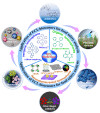Nanomaterials-Based Electrochemiluminescence Biosensors for Food Analysis: Recent Developments and Future Directions
- PMID: 36421164
- PMCID: PMC9688497
- DOI: 10.3390/bios12111046
Nanomaterials-Based Electrochemiluminescence Biosensors for Food Analysis: Recent Developments and Future Directions
Abstract
Developing robust and sensitive food safety detection methods is important for human health. Electrochemiluminescence (ECL) is a powerful analytical technique for complete separation of input source (electricity) and output signal (light), thereby significantly reducing background ECL signal. ECL biosensors have attracted considerable attention owing to their high sensitivity and wide dynamic range in food safety detection. In this review, we introduce the principles of ECL biosensors and common ECL luminophores, as well as the latest applications of ECL biosensors in food analysis. Further, novel nanomaterial assembly strategies have been progressively incorporated into the design of ECL biosensors, and by demonstrating some representative works, we summarize the development status of ECL biosensors in detection of mycotoxins, heavy metal ions, antibiotics, pesticide residues, foodborne pathogens, and other illegal additives. Finally, the current challenges faced by ECL biosensors are outlined and the future directions for advancing ECL research are presented.
Keywords: biosensors; electrochemiluminescence; food analysis; nanomaterials.
Conflict of interest statement
The authors declare no conflict of interest.
Figures





Similar articles
-
Strategies for Enhancing the Sensitivity of Electrochemiluminescence Biosensors.Biosensors (Basel). 2022 Sep 11;12(9):750. doi: 10.3390/bios12090750. Biosensors (Basel). 2022. PMID: 36140135 Free PMC article. Review.
-
Highly sensitive bioaffinity electrochemiluminescence sensors: Recent advances and future directions.Biosens Bioelectron. 2019 Oct 1;142:111530. doi: 10.1016/j.bios.2019.111530. Epub 2019 Jul 22. Biosens Bioelectron. 2019. PMID: 31398687 Review.
-
Research progress on electrochemiluminescence nanomaterials and their applications in biosensors - A review.Anal Chim Acta. 2025 Aug 1;1361:344148. doi: 10.1016/j.aca.2025.344148. Epub 2025 May 11. Anal Chim Acta. 2025. PMID: 40414672 Review.
-
Recent development of electrochemiluminescence sensors for food analysis.Anal Bioanal Chem. 2016 Oct;408(25):7035-48. doi: 10.1007/s00216-016-9548-2. Epub 2016 Apr 16. Anal Bioanal Chem. 2016. PMID: 27086020 Review.
-
Recent Progress in Plasmonic based Electrochemiluminescence Biosensors: A Review.Biosensors (Basel). 2023 Jan 29;13(2):200. doi: 10.3390/bios13020200. Biosensors (Basel). 2023. PMID: 36831966 Free PMC article. Review.
Cited by
-
Laser-Treated Screen-Printed Carbon Electrodes for Electrochemiluminescence imaging.Chem Biomed Imaging. 2024 Nov 22;2(12):835-841. doi: 10.1021/cbmi.4c00070. eCollection 2024 Dec 23. Chem Biomed Imaging. 2024. PMID: 39735830 Free PMC article.
-
Sensors for in situ monitoring of oral and dental health parameters in saliva.Clin Oral Investig. 2023 Oct;27(10):5719-5736. doi: 10.1007/s00784-023-05206-9. Epub 2023 Sep 12. Clin Oral Investig. 2023. PMID: 37698630 Free PMC article. Review.
-
(Bio)Electroanalysis of Tetracyclines: Recent Developments.Biosensors (Basel). 2025 Feb 11;15(2):101. doi: 10.3390/bios15020101. Biosensors (Basel). 2025. PMID: 39997003 Free PMC article. Review.
-
Immunosensors for Assay of Toxic Biological Warfare Agents.Biosensors (Basel). 2023 Mar 20;13(3):402. doi: 10.3390/bios13030402. Biosensors (Basel). 2023. PMID: 36979614 Free PMC article. Review.
-
Multivariate Optimization of Electrochemical Biosensors for the Determination of Compounds Related to Food Safety-A Review.Biosensors (Basel). 2023 Jun 30;13(7):694. doi: 10.3390/bios13070694. Biosensors (Basel). 2023. PMID: 37504093 Free PMC article. Review.
References
-
- Wang J., Yao L., Huang W., Yang Y., Liang W., Yuan R., Xiao D. Overcoming Aggregation-Induced Quenching by Metal-Organic Framework for Electrochemiluminescence (ECL) Enhancement: Zn-PTC as a New ECL Emitter for Ultrasensitive MicroRNAs Detection. ACS Appl. Mater. Interfaces. 2021;13:44079–44085. doi: 10.1021/acsami.1c13086. - DOI - PubMed
-
- Li S., Liu Y., Ma Q. Nanoparticle-based electrochemiluminescence cytosensors for single cell level detection. Trends Anal. Chem. 2019;110:277–292. doi: 10.1016/j.trac.2018.11.019. - DOI
Publication types
MeSH terms
Grants and funding
LinkOut - more resources
Full Text Sources

